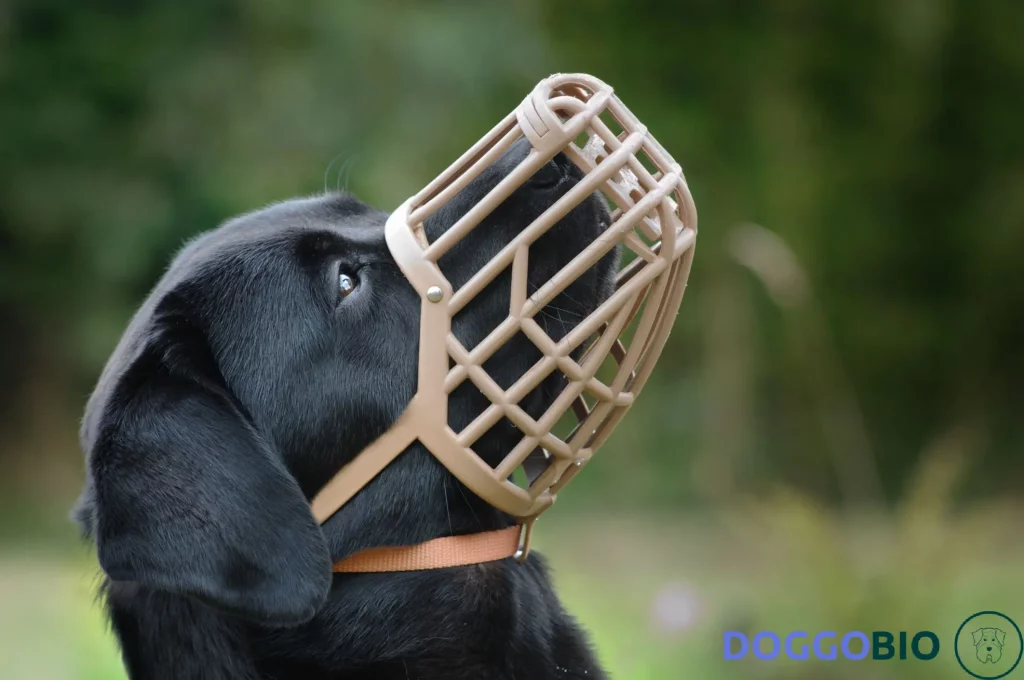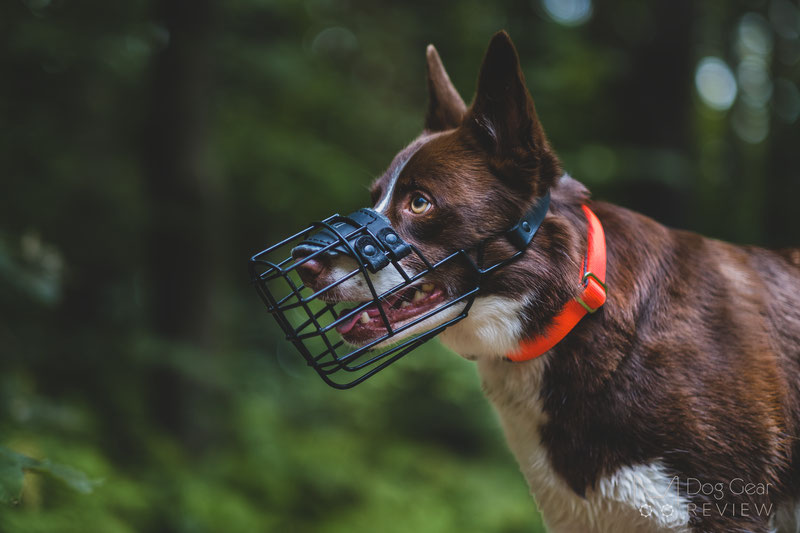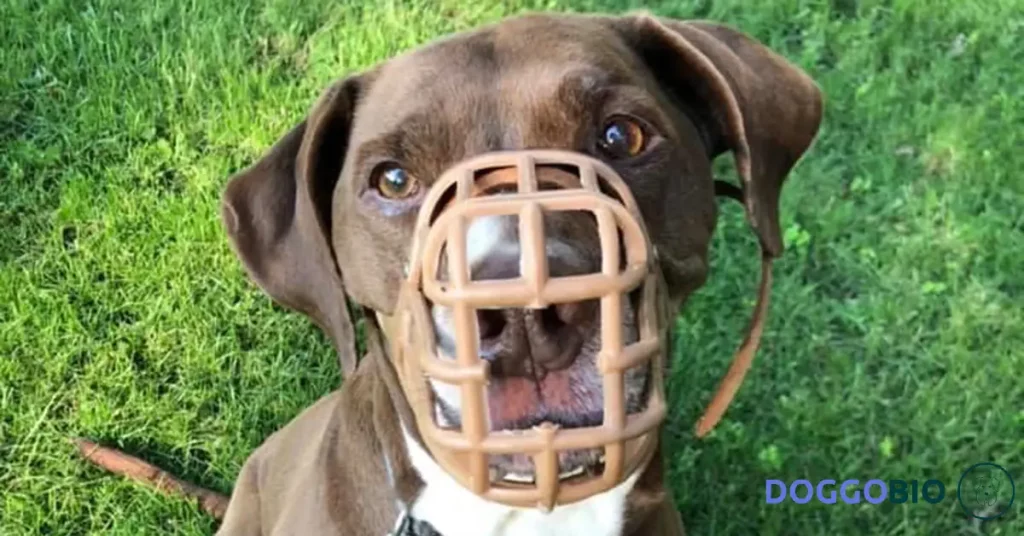Welcome to this guide on how to put a muzzle on a dog, including training for the dog! If you have a dog that is prone to biting or showing aggressive behavior, a muzzle can be an effective tool to help keep both your dog and others safe.
However, knowing how to properly put on a muzzle, as well as training your dog to be comfortable with it, is important to ensure your dog’s comfort and safety. In this guide, we will walk you through the steps of putting on a dog muzzle, training your dog to wear one, and some tips for acclimating your dog to it.
Whether you’re a first-time dog owner or just looking for a refresher on muzzle training, this guide will provide you with the information you need to use a dog muzzle safely and effectively.
Why is it important to wear a dog muzzle?
Dog muzzles are a topic of fierce debate among pet owners. They tend to elicit strong reactions, as many people associate them with aggressive or attack dogs.
However, experts in the field of canine care assert that at some point in a dog’s life, a muzzle may become necessary for the safety of the dog, a person, or both.
For instance, if your furry friend suffers a severe injury, the likelihood of a dog bite escalates substantially. During times of intense pain, dogs may lash out when attempting to transport or treat them.
Unfortunately, it is impossible to predict when such circumstances will arise. As a result, it is prudent to comprehend the reasons, occasions, and methods for utilizing a dog muzzle, even if you never have to use one.
Furthermore, it is essential to train your dog to tolerate and accept wearing a muzzle. Every dog should be taught to relish donning a muzzle so that if the need ever arises, you and your dog will be less stressed.
It is also vital to understand that muzzles should never be used as a form of punishment, and dogs must not be left unattended while muzzled.
When Is it Appropriate to Use a Dog Muzzle?
The answer is not always clear-cut, and requires careful consideration of the situation at hand. Let’s explore some scenarios in which using a dog muzzle may be safe and necessary.

1.In an emergency
Firstly, in the case of an emergency, a muzzle can be a valuable tool to keep everyone involved safe. A dog who is injured or frightened may lash out, even if that behavior is out of character. A muzzle can prevent anyone from getting hurt while trying to provide assistance.
2.They have a history of Biting or a risk of biting
In instances where there is a history of biting or a risk of biting, the use of a muzzle is a prudent course of action.
Even if the dog has no previous bite history, if the risk of a dog bite is perceived, such as when the dog lunges and barks at other dogs or people, a muzzle can be an effective tool for ensuring everyone’s safety.
It is important to note, however, that a dog muzzle is not a solution to the problem but a temporary measure to keep everyone safe while working on behavior modification with an animal behaviorist, veterinarian, and/or dog trainer.
3.During veterinary examinations
Similarly, if your dog is at risk of biting due to a threatening situation, such as during veterinary examinations, the temporary use of a muzzle may be appropriate.
However, this should also serve as a signal that long-term behavior modification is necessary to address the underlying issues.
4.During grooming sessions
During grooming sessions, a muzzle for dogs may be helpful in some cases. While most dogs can be trained to tolerate or even enjoy grooming procedures, some may be more sensitive or require more time to adjust.
In these cases, a muzzle can provide an extra layer of safety for the groomer and the dog.
5.Breed-specific legislation (BSL)
Finally, in some regions, breed-specific legislation may require certain breeds to wear muzzles when outside of private property. While this is a controversial topic, it’s important to comply with local laws and regulations to keep everyone safe.
In conclusion, the decision to use a dog muzzle requires careful consideration of the situation at hand. While it can be a valuable tool in some cases, it should never be used as a substitute for proper training and behavior modification.
When in doubt, consult with a professional to determine the best course of action for your dog’s specific needs.
When to Refrain From Using a Dog Muzzle?
The use of a dog muzzle might appear like a no-brainer to prevent dog bites. However, they are not suitable for dealing with behavioral issues such as barking, chewing, or any other persistent problems. There are a couple of critical reasons for this.

1.Use to prevent behaviors such as barking, chewing
Firstly, dog muzzles are meant to be used for short durations under supervision. However, issues like barking and chewing persist over extended periods, and a muzzle is only a temporary tool, making it an unsuitable solution.
If you want to make progress with these problems, you need to apply consistent training and behavior modification techniques.
2.When the dog feels stressed and uncomfortable
Moreover, never use a muzzle to put your dog in a stressful or unnecessary situation. Rather than muzzling your dog to get through a stressful event, work on changing your dog’s reaction to it.
If you muzzle your dog in a stressful situation, your dog will associate the situation with the muzzle, thus adding more anxiety and fear to the next event.
3.Use as punishment
Similarly, it’s crucial to avoid using a muzzle as punishment. Muzzling your dog as punishment will not address the underlying problem.
Instead, your dog will associate the muzzle with the punishment, making them more nervous and scared the next time you use the muzzle.
Ultimately, this could have dire consequences in emergency situations, making it difficult to use the muzzle when necessary.
How To Put A Muzzle On Your Dog?
The proper use of a dog muzzle is essential to ensure the safety of both your pet and others. However, the training process to get your pup acclimated to the muzzle can be a daunting task.
Fear not, for we have compiled a detailed guide to help you put a muzzle on your furry friend like a pro.

Step 1: Showing the dog muzzle.
First and foremost, it is important to note that introducing the dog muzzle to your pup is just as crucial as having him wear it.
To make the training process more enjoyable for your dog, it is recommended to approach it with a positive mindset.
Incorporating fun activities and treats into the training regimen can help your pup develop a positive association with the muzzle.
Step 2 : Exploring the dog muzzle.
When getting started, keep in mind that dogs use their sense of smell to explore the world around them.
In order to introduce the muzzle to your dog, use a tasty incentive like peanut butter to entice him to place his snout inside the muzzle.
The scent of the peanut butter will naturally draw your dog towards the muzzle and encourage him to explore it.
However, it is important to remember that you should never force the muzzle onto your pup’s snout.
Doing so can cause undue stress and anxiety for your pet, and potentially cause him to associate the muzzle with negative experiences. Instead, allow your dog to voluntarily place his snout into the muzzle at his own pace during the training process.
Step 3: Release buckles and safety straps.
Another key consideration when training your dog to wear a muzzle is his sensitivity to noise. Dogs have a keen sense of hearing and can become uncomfortable with loud or sudden sounds.
Therefore, it is crucial that your dog becomes accustomed to the sound of the buckles when fastening and releasing the muzzle.
To achieve this, it is recommended that you repeat the process of fastening and releasing the muzzle several times while providing treats and positive reinforcement to your dog.
Over time, your pup should begin to associate the sound of the buckles with treats and feel more comfortable with the process.
Step 4 : Fasten the buckle
Lastly, ensure that the safety straps on the muzzle are adjustable and that the muzzle fits securely and comfortably on your dog’s snout.
It is important that the muzzle is not too tight or too loose as this can cause discomfort and potentially result in your dog being able to remove the muzzle.
In conclusion, training your dog to wear a muzzle can be a challenging task, but with patience, positive reinforcement, and the right approach, it can be a successful and stress-free process for both you and your furry friend.
The difference of dog muzzles

Two main types of muzzles are available on the market: the basket muzzle and the soft muzzle. By selecting the appropriate type and fit, you can ensure the effectiveness and safety of their use.
In the rare circumstance that neither option is feasible, one can improvise with a homemade muzzle, but this should only be a temporary solution.
1.Basket muzzle
The basket muzzle is a robust and rugged option that resembles a prison cell for a dog’s snout. Despite its formidable appearance, it is arguably the most humane option, as it does not impede a dog’s ability to open their mouth to pant, drink, or eat.
Additionally, basket muzzles are available in various materials, including leather, wire, plastic, and rubber, and can be tailored to the dog’s specific anatomy for optimal comfort.
2.Soft muzzle
On the other hand, the soft muzzle, typically fashioned from fabric such as nylon or mesh, is a more comfortable option for dogs initially.
However, it is crucial to note that soft muzzles, unlike their basket counterparts, limit a dog’s ability to pant, which is their primary way of releasing heat.
As such, these muzzles should only be used for brief periods and never in hot weather. Soft muzzles also obstruct a dog’s ability to bark, eat, or drink, and using treats as a reward during behavioral modification programs or training sessions becomes arduous without the ability to chew.
3.Homemade muzzle
In the unlikely event that neither basket nor soft muzzles are available, and you must muzzle your dog, you can make a homemade muzzle from common household items.
While there are various online tutorials available for improvising a makeshift dog muzzle with a roll of gauze, a pair of pantyhose, or even your dog’s leash, such items are not the ideal materials to use.
It is best to have a proper muzzle on hand as part of your canine first aid kit, or at least know where to purchase one in the case of an emergency.
How to choose a suitable muzzle for dogs?
The proper fit of a muzzle is paramount to its effective use. Achieving the right fit can be tricky, however. If the muzzle is too loose, it will allow your dog to easily remove it.
Conversely, if it’s too tight, it can impede their breathing, panting, and drinking abilities, not to mention cause painful chafing. In order to ensure a comfortable and secure fit, straps should be adjusted so that only one finger can fit between your dog’s head and the strap.
It’s important to keep in mind that sizing can vary between different muzzle styles and brands, so trying on various sizes and consulting with a knowledgeable professional trainer or experienced muzzle user can be beneficial.
Taking measurements, especially when purchasing online, is also recommended. Even flat-faced dogs like Pugs can wear muzzles, though a custom-fitted option may be ideal.
There are also various types of muzzles available that are specifically designed for dogs who are known bite risks or have different face shapes.
It’s worth noting that muzzles should not be viewed as a solution to behavioral issues. While they can be a useful tool, dog experts unanimously agree that consistent, positive training is the only way to address behavioral problems effectively.
Muzzles can serve as a temporary measure for managing a dog’s behavior while training is taking place, but should never be used as a long-term solution.
Conclusion
In conclusion, putting on a dog muzzle can be a simple and effective way to prevent biting and aggressive behavior in dogs. By following the steps outlined in this guide, you can ensure that your dog’s muzzle is fitted properly, comfortable, and safe to wear.
Remember to never use a muzzle as a substitute for proper training and socialization, and always supervise your dog when they are wearing a muzzle. With patience and positive reinforcement, your dog can learn to tolerate and even enjoy wearing a muzzle, making it a valuable tool for keeping them and others safe in a variety of situations.
